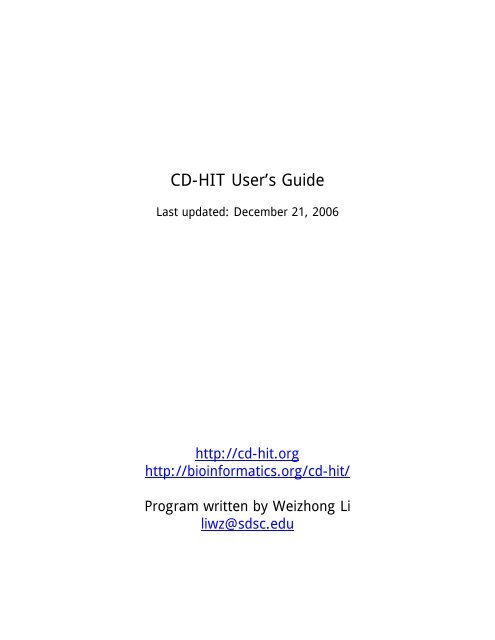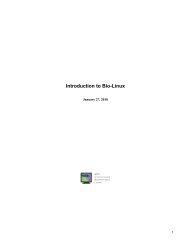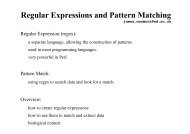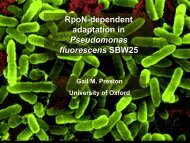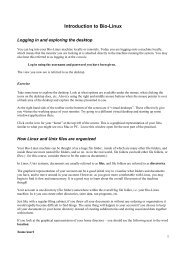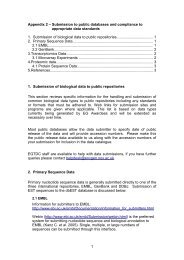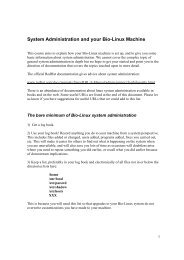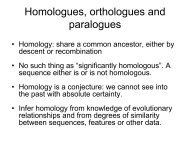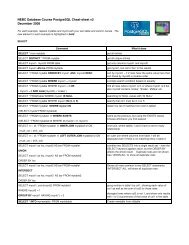CD-HIT User's Guide
CD-HIT User's Guide
CD-HIT User's Guide
You also want an ePaper? Increase the reach of your titles
YUMPU automatically turns print PDFs into web optimized ePapers that Google loves.
<strong>CD</strong>-<strong>HIT</strong> User’s <strong>Guide</strong>Last updated: December 21, 2006http://cd-hit.orghttp://bioinformatics.org/cd-hit/Program written by Weizhong Liliwz@sdsc.edu
1. Introduction2. Algorithm2.1. cd-hit clustering algorithm2.2. algorithm limitations2.3. cd-hit-2d comparing algorithm2.4. DNA/RNA clustering & comparing2.5. psi-cd-hit algorithm3. User’s <strong>Guide</strong>3.1. installation3.2. cd-hit3.3. cd-hit-2d3.4. cd-hit-est3.5. cd-hit-est-2d3.6. cd-hit-para.pl, cd-hit-2d-para.pl3.7. psi-cd-hit.pl3.8. psi-cd-hit-2d.pl3.9. incremental clustering3.10. hierarchically clustering4. <strong>CD</strong>-<strong>HIT</strong> tools4.1. plot_len.pl4.2. clstr_sort.pl4.3. clstr_merge.pl4.4. clstr_renumber.pl4.5. clstr_rev.pl5. FAQ6. References
Introduction<strong>CD</strong>-<strong>HIT</strong> was originally a protein clustering program. The main advantage of this programis its ultra-fast speed. It can be hundreds of times faster than other clustering programs, forexample, BLASTCLUST. Therefore it can handle very large databases, like NR.The 1 st version of this program, <strong>CD</strong>-HI, was published and released in 2001. The 2 ndversion, called <strong>CD</strong>-<strong>HIT</strong>, was published in 2002 with significant improvements. Since 2004,<strong>CD</strong>-<strong>HIT</strong> has been hosted at bioinformatics.org as an open source project.Since its release, <strong>CD</strong>-<strong>HIT</strong> has been getting more and more popular. It has a significant userbase, I estimated at over 1000 users. It is used at many research and educational institutions.For example, at UniProt, <strong>CD</strong>-<strong>HIT</strong> is used to generate the UniRef reference data sets(http://www.pir.uniprot.org/database/DBDescription.shtml). It is also used in PDB to treatredundant sequences (http://rutgers.rcsb.org/pdb/redundancy.html).Since 2005, I started the further development of <strong>CD</strong>-<strong>HIT</strong>, added more features to existingprograms and wrote several new applications. Currently, I have 9 programs in the <strong>CD</strong>-<strong>HIT</strong>package: cd-hit, mcd-hit, cd-hit-2d, cd-hit-est, cd-hit-est-2d, cd-hit-para, cd-hit-2d-para,psi-cd-hit, psi-cd-hit-2d. I also developed some utility tools, written in Perl, to help run andanalyze <strong>CD</strong>-<strong>HIT</strong> jobs.Current <strong>CD</strong>-<strong>HIT</strong> package can perform various jobs like clustering a protein database,clustering a DNA/RNA database, comparing two databases (protein or DNA/RNA),generating protein families, and many others.This program is still under active development, new features and new programs will be outin the future.
AlgorithmAlgorithms for <strong>CD</strong>-HI and <strong>CD</strong>-<strong>HIT</strong> were described in three papers published inBioinformatics.1. Clustering of highly homologous sequences to reduce the size of large protein databases.Weizhong Li, Lukasz Jaroszewski & Adam Godzik. Bioinformatics (2001) 17:282-283,PDF, Pubmed2. Tolerating some redundancy significantly speeds up clustering of large protein databases.Weizhong Li, Lukasz Jaroszewski & Adam Godzik. Bioinformatics (2002) 18: 77-82, PDF,Pubmed3. Cd-hit: a fast program for clustering and comparing large sets of protein ornucleotide sequences. Weizhong Li & Adam Godzik. Bioinformatics (2006)22:1658-1659 PDF, PubmedI suggest that you read these papers if (1) you want to understand more details about thealgorithm or (2) you want know why it is so fast. If you don’t have time to read thesepapers, the algorithms are summarized below.<strong>CD</strong>-<strong>HIT</strong> clustering algorithmClustering a sequence database requires all-by-all comparisons; therefore it is very timeconsuming.Many methods use BLAST to compute the all vs. all similarities. It is verydifficult for these methods to cluster large databases. While <strong>CD</strong>-<strong>HIT</strong> can avoid manypairwise sequence alignments with a short word filter I developed.In <strong>CD</strong>-<strong>HIT</strong>, I use greedy incremental clustering algorithm method. Briefly, sequences arefirst sorted in order of decreasing length. The longest one becomes the representative of thefirst cluster. Then, each remaining sequence is compared to the representatives of existingclusters. If the similarity with any representative is above a given threshold, it is groupedinto that cluster. Otherwise, a new cluster is defined with that sequence as therepresentative.Here is how the short word filter works. Two proteins with a certain sequence identity musthave at least a specific number of identical dipeptides, tripeptides and etc. For example, fortwo sequences to have 85% identity over a 100-residue window they have to have at least70 identical dipeptides, 55 identical tripeptides, and 25 identical pentapeptides. Byunderstanding the short word requirement, <strong>CD</strong>-<strong>HIT</strong> skips most pairwise alignments becauseit knows that the similarity of two sequences is below certain threshold by simple wordcounting.
Another reason why <strong>CD</strong>-<strong>HIT</strong> is so fast is the use of an index table. I just use very shortword with size 2~5. For instance, the total number of possible pentapeptides is only 21 5(each position has 21 possibilities, 20 amino acids plus “X”), and the index table requiresonly 4 million entries, which just matches the RAM scale of current computers. Index tablemakes the counting of short word very efficiently. And a longer word is more efficient thana shorter one.Algorithm limitationsA limitation of short word filter is that it can not be used below certain clusteringthresholds. In a worst case scenario (figure below), when mismatches are evenly distributedalong the alignment, the numbers of common short words are minimal. So theoretically,pentapeptide, tetrapeptide, tripeptide and dipeptide could only be used for thresholds above80%, 75%, 66.67% and 50% respectively.Short word filtering is limited to certain clustering thresholds. Evenlydistributed mismatches are shown in alignments with 80%, 75%, 66.67%and 50% sequence identities. The number of common pentapeptides in (a),tetrapeptides in (b), tripeptides in (c), and dipeptides in (d) can be zero.However, biological sequences are not lines of random letters; proteins usually have moreconserved regions and more diverse regions as the result of specific constraints ofevolution. Situations such as in above figure are very rare in the real world, and the actualnumber of common short words is much higher than in the worst case scenarios. We did alarge-scale statistical analysis on short words. We found, for example, even at 70% identity,sequences still have statistically significant number of common pentapeptides. Current <strong>CD</strong>-<strong>HIT</strong> is based on this short word statistics. But the short word filters are still limited tocertain thresholds. The reasonable limits of clustering thresholds for pentapeptide,tetrapeptide, tripeptide and dipeptide are approximately 70%, 60%, 50% and 40%,respectively.There is another problem introduced by the greedy incremental clustering. Let say, thereare two clusters: cluster #1 has A, X and Y where A is the representative, and cluster #2has B and Z where B is the representative. The problem is that even if Y is more similar toB than to A, it can still in cluster #1, simple because Y first hit A during clustering process.While this problem could be reduced by multiple-step clustering (see following sections).
<strong>CD</strong>-<strong>HIT</strong>-2D comparing algorithmThe above short word filtering and index table can also be used in other sequencecomparison tasks, for example, comparing two data sets and reporting the matches between2 datasets over a certain similarity threshold. This is a very common job, so I developedanother program cd-hit-2d for fast comparison of two dataset.DNA / RNA clustering & comparingThe original <strong>CD</strong>-<strong>HIT</strong> was developed for protein clustering. But the short word filtering andindex table implementation can also be applied to DNA / RNA. Therefore, I wrote anothertwo new programs cd-hit-est and cd-hit-est-2d. I believe they can be very useful inhandling EST sequences.PSI-<strong>CD</strong>-<strong>HIT</strong> clusteringThe lowest threshold of <strong>CD</strong>-<strong>HIT</strong> is around 40%, in many applications, people need a muchlower threshold, like 25%. I am planning develop such application (may be called <strong>CD</strong>-<strong>HIT</strong>-LOW, I don’t know yet), but for now, I use PSI-<strong>CD</strong>-<strong>HIT</strong> for this purpose.PSI-<strong>CD</strong>-<strong>HIT</strong> is actually a Perl script I wrote, which runs similar algorithm like <strong>CD</strong>-<strong>HIT</strong> butusing BLAST to calculate similarities. Below are the procedures of PSI-<strong>CD</strong>-<strong>HIT</strong>:1. Sort sequences by decreasing length2. First one is the first representative3. Using 1 st one blast all remaining sequences, pick up its neighbors that meet the clusteringthreshold4. Repeat until done
User’s <strong>Guide</strong>InstallationMost <strong>CD</strong>-<strong>HIT</strong> programs were written in C++. Installing <strong>CD</strong>-<strong>HIT</strong> package is very simple:1. download current <strong>CD</strong>-<strong>HIT</strong> at http://bioinformatics.org/cd-hit/, for example cd-hit-2006-0215.tar.gz2. unpack the file with “tar xvf cd-hit-2006-0215.tar.gz --gunzip”3. change dir by “cd cd-hit-2006”4. compile the programs by “make”5. you will have all cd-hit programs compiledThere are some macros defined in a cd-hi.h that control some basic parameters. I believe, in99% of the case, that these setting are fine. But you can change them also. I list some ofthem here:#define MAX_SEQ 65536Max length of sequences.#define MAX_DIAG 133000This number should be the double of MAX_SEQ.#define MAX_GAP 65536Max allowed gap length in dynamic programming subroutine.#define MAX_LINE_SIZE 300000Max allowed length of a single line from input FASTA file.#define MAX_FILE_NAME 1280Max allowed length of filename.#define MAX_SEG 50For large database, the program divides it into several parts,this number is max allowed No. of parts.<strong>CD</strong>-<strong>HIT</strong><strong>CD</strong>-<strong>HIT</strong> clusters proteins into clusters that meet a user-defined similarity threshold, usuallya sequence identity. Each cluster has one representative sequence. The input is a proteindataset in fasta format and the output are two files: a fasta file of representative sequencesand a text file of list of clusters.Basic command:cd-hit -i nr -o nr100 -c 1.00 -n 5 -M 2000cd-hit -i db -o db90 -c 0.9 -n 5, wheredb is the filename of input,
db90 is output,0.9, means 90% identity, is the clustering threshold5 is the size of wordChoose of word size:-n 5 for thresholds 0.7 ~ 1.0-n 4 for thresholds 0.6 ~ 0.7-n 3 for thresholds 0.5 ~ 0.6-n 2 for thresholds 0.4 ~ 0.5Complete options:-i input input filename in fasta format, required-o output filename, required-c sequence identity threshold, default 0.9this is the default cd-hit's "global sequence identity"calculated as:number of identical amino acids in alignmentdivided by the full length of the shorter sequence-G use global sequence identity, default 1if set to 0, then use local sequence identity, calculated as :number of identical amino acids in alignmentdivided by the length of the alignmentNOTE!!! don't use -G 0 unless you use alignment coverage controlssee options -aL, -AL, -aS, -AS-b band_width of alignment, default 20-M max available memory (Mbyte), default 400-n word_length, default 5, see user's guide for choosing it-l length of throw_away_sequences, default 10-t tolerance for redundance, default 2-d length of description in .clstr file, default 20if set to 0, it takes the fasta defline and stops at first space-s length difference cutoff, default 0.0if set to 0.9, the shorter sequences need to beat least 90% length of the representative of the cluster-S length difference cutoff in amino acid, default 999999if set to 60, the length difference between the shorter sequencesand the representative of the cluster can not be bigger than 60-aL alignment coverage for the longer sequence, default 0.0if set to 0.9, the alignment must covers 90% of the sequence-AL alignment coverage control for the longer sequence, default 99999999if set to 60, and the length of the sequence is 400,then the alignment must be >= 340 (400-60) residues-aS alignment coverage for the shorter sequence, default 0.0if set to 0.9, the alignment must covers 90% of the sequence-AS alignment coverage control for the shorter sequence, default 99999999if set to 60, and the length of the sequence is 400,then the alignment must be >= 340 (400-60) residues-B 1 or 0, default 0, by default, sequences are stored in RAMif set to 1, sequence are stored on hard driveit is recommended to use -B 1 for huge databases-p 1 or 0, default 0if set to 1, print alignment overlap in .clstr file
-g 1 or 0, default 0By cd-hit’s default algorithm, a sequence is clustered to the firstcluster that meet the threshold (fast mode). If set to 1, the programwill cluster it into the most similar cluster that meet the threshold(accurate but slow mode)Output:The output .clstr file looks like>Cluster 00 2799aa, >PF04998.6|RPOC2_CHLRE/275-3073... *>Cluster 10 2214aa, >PF06317.1|Q6Y625_9VIRU/1-2214... at 80%1 2215aa, >PF06317.1|O09705_9VIRU/1-2215... at 84%2 2217aa, >PF06317.1|Q6Y630_9VIRU/1-2217... *3 2216aa, >PF06317.1|Q6GWS6_9VIRU/1-2216... at 84%4 527aa, >PF06317.1|Q67E14_9VIRU/6-532... at 63%>Cluster 20 2202aa, >PF06317.1|Q6UY61_9VIRU/8-2209... at 60%1 2208aa, >PF06317.1|Q6IVU4_JUNIN/1-2208... *2 2207aa, >PF06317.1|Q6IVU0_MACHU/1-2207... at 73%3 2208aa, >PF06317.1|RRPO_TACV/1-2208... at 69%Where,a “>” starts a new clustera “*” at the end means that this sequence is the representative ofthis clustera “%” is the identity between this sequence and the representativeM<strong>CD</strong>-<strong>HIT</strong>M<strong>CD</strong>-<strong>HIT</strong> is modified version of <strong>CD</strong>-<strong>HIT</strong>. It cuts long proteins into ~400aa pieces toimprove short-word filtering efficiency. It is more suitable for datasets that contain proteinsof very different lengths and at low clustering threshold
5 is the size of wordPlease note that by default, I only list matches where sequences in db2 are not longer thansequences in db1. You may use options -S2 or -s2 to overwrite this default. You can alsorun command:cd-hit-2d -i db2 -i2 db1 -o db1novel -c 0.9 -n 5Choose of word size (same as cd-hit):-n 5 for thresholds 0.7 ~ 1.0-n 4 for thresholds 0.6 ~ 0.7-n 3 for thresholds 0.5 ~ 0.6-n 2 for thresholds 0.4 ~ 0.5More options:Options, -b, -M, -l, -d, -t, -s, -S, -B, -p, -aL, -AL, -aS, -AS, -g, -G are same to <strong>CD</strong>-<strong>HIT</strong>,here are few more cd-hit-2d specific options:-i2 input filename for db2 in fasta format, required-s2 length difference cutoff for db1, default 1.0by default, seqs in db1 >= seqs in db2 in a same clusterif set to 0.9, seqs in db1 may just >= 90% seqs in db2-S2 length difference cutoff, default 0by default, seqs in db1 >= seqs in db2 in a same clusterif set to 60, seqs in db2 may 60aa longer than seqs in db1<strong>CD</strong>-<strong>HIT</strong>-EST<strong>CD</strong>-<strong>HIT</strong>-EST clusters a nucleotide dataset into clusters that meet a user-defined similaritythreshold, usually a sequence identity. The input is a DNA/RNA dataset in fasta formatand the output are two files: a fasta file of representative sequences and a text file of list ofclusters.Since eukaryotic genes usually have long introns, which cause long gaps, it is difficult tomake full-length alignments for these genes. So, <strong>CD</strong>-<strong>HIT</strong>-EST is good for non-introncontaining sequences like EST.Basic command:cd-hit-est -i est_human -o est_human95 -c 0.95 -n 8Choose of word size:-n 8,9,10 for thresholds 0.90 ~ 1.0-n 7 for thresholds 0.88 ~ 0.9-n 6 for thresholds 0.85 ~ 0.88-n 5 for thresholds 0.80 ~ 0.85-n 4 for thresholds 0.75 ~ 0.8
More options:Options, -b, -M, -l, -d, -t, -s, -S, -B, -p, -aL, -AL, -aS, -AS, -g, -G are same to <strong>CD</strong>-<strong>HIT</strong>,here are few more cd-hit-est specific options:-r 1 or 0, default 0, if set to 1, comparing both strand (++, +-)<strong>CD</strong>-<strong>HIT</strong>-EST-2D<strong>CD</strong>-<strong>HIT</strong>-EST-2D compares 2 nucleotide datasets (db1, db2). It identifies the sequences indb2 that are similar to db1 at a certain threshold. The input are two DNA/RNA datasets(db1, db2) in fasta format and the output are two files: a fasta file of sequences in db2 thatare not similar to db1 and a text file that lists similar sequences between db1 & db2.For same reason as <strong>CD</strong>-<strong>HIT</strong>-EST, <strong>CD</strong>-<strong>HIT</strong>-EST-2D is good for non-intron containingsequences like EST.Basic command:cd-hit-est-2d -i mrna_human -i2 est_human -o est_human_novel -c0.95 -n 8Choose of word size (same as <strong>CD</strong>-<strong>HIT</strong>-EST):-n 8,9,10 for thresholds 0.90 ~ 1.0-n 7 for thresholds 0.88 ~ 0.9-n 6 for thresholds 0.85 ~ 0.88-n 5 for thresholds 0.80 ~ 0.85-n 4 for thresholds 0.75 ~ 0.8More options:Options, -b, -M, -l, -d, -t, -s, -S, -s2, -S2, -B, -p, -aL, -AL, -aS, -AS, -g, -G are same to <strong>CD</strong>-<strong>HIT</strong>-2d, here are few more cd-hit-est-2d specific options:-r 1 or 0, default 0, if set to 1, comparing both strand (++, +-)<strong>CD</strong>-<strong>HIT</strong>-PARA<strong>CD</strong>-<strong>HIT</strong>-PARA is a script that runs cd-hit, cd-hit-est in a parallel mode. It splits the inputdatabase; runs cd-hit or cd-hit-est in parallel on a computer cluster; and finally merges theoutputs into a single file. You can run it as you run cd-hit or cd-hit-est. The input is aprotein or DNA/RAN dataset in fasta format and the output are two files: a fasta file ofrepresentative sequences and a text file of list of clusters.There are two ways to run jobs on a cluster: by ssh to a remote computer and by queuingsystem (PBS and SGE are implemented). In any case, you should have a shared file system,the path to your working directory must be same on all the remote computers.
This script can also be used if you are clustering a very large database and your computerdoesn’t have enough RAM. In that case, all the divided jobs will still run on a singlecomputer.Implementation (see figure below)1. divide input db into many small dbs in decreasing length2. clusters the 1 st db by cd-hit3. run cd-hit-2d for other dbs against 1 st db4. repeat cd-hit and cd-hit-2d runs till done5. Combine the resultsBasic command:cd-hit-para.pl -i nr90 -o nr60 -c 0.6 -n 4 --B hosts --S 64, where--B hosts is a file with available hostnames--S 64 is the number to split input db into, this numbershould be several times the number of hostsMore options:--P program, "cd-hit" or "cd-hit-est", default "cd-hit"--B filename of list of hosts,requred unless -Q or -L option is supplied--L number of cpus on local computer, default 0when you are not running it over a cluster, you can usethis option to divide a big clustering jobs into smallpieces, I suggest you just use "--L 1" unless you haveenough RAM for each cpu--S Number of segments to split input DB into, default 64--Q number of jobs to submit to queue queuing system, default 0by default, the program use ssh mode to submit remote jobs--T type of queuing system, "PBS", "SGE" are supported, defaultPBS--R restart file, used after a crash of run
<strong>CD</strong>-<strong>HIT</strong>-2D-PARA<strong>CD</strong>-<strong>HIT</strong>-2D-PARA is a script that runs cd-hit-2d, cd-hit-est-2d in a parallel mode. It splitsthe input databases; runs cd-hit-2d or cd-hit-est-2d in parallel on a computer cluster; andfinally merges the outputs into a single file. You can run it as you run cd-hit-2d or cd-hitest-2d.The input is a protein or DNA/RAN dataset in fasta format and the output are twofiles: a fasta file of representative sequences and a text file of list of clusters.Basic command:cd-hit-para.pl -i nr –i2 swissprot -o swissprot_vs_nr -c 0.6 -n 4--Q 20 –T "SGE" --S 2 --S2 20, where--P program, "cd-hit-2d" or "cd-hit-est-2d",default "cd-hit-2d"--B filename of list of hosts,requred unless -Q or -L option is supplied--L number of cpus on local computer, default 0when you are not running it over a cluster, you can usethis option to divide a big clustering jobs into smallpieces, I suggest you just use "--L 1" unless you haveenough RAM for each cpu--S Number of segments to split 1st db into, default 2--S2 Number of segments to split 2nd db into, default 8--Q number of jobs to submit to queue queuing system, default0by default, the program use ssh mode to submit remotejobs--T type of queuing system, "PBS", "SGE" are supported,default PBS--R restart file, used after a crash of run-h print this helpPSI-<strong>CD</strong>-<strong>HIT</strong> clusteringPSI-<strong>CD</strong>-<strong>HIT</strong> clusters proteins into clusters that meet a user-defined similarity threshold,which can be identity or expect value. Each cluster has one representative sequence. Theinput is a protein dataset in fasta format and the output are two files: a fasta file ofrepresentative sequences and a text file of list of clustersBasic command:psi-cd-hit.pl -i nr60 -o nr30 -c 0.3psi-cd-hit.pl -i nr60 -o nr30 -c 0.3 -b hostsMore options:Options, -l, -d, -s, -S are same to <strong>CD</strong>-<strong>HIT</strong>, here are few more psi-cd-hit specific options:
-ce clustering threshold (blast expect), default -1, by default itdoesn't use expect threshold, but with positive value, theprogram cluster sequences if similarities meet either identitythreshold or expect value threshold-L coverage of shorter sequence (aligned / full), default 0-M coverage of longer sequence (aligned / full), default 0-R (1/0) use psi-blast profile? default 0, perform psi-blast /pdb-blast type search-G (1/0) use global identity? default 1, sequence identitycalculated as total identical residues of local alignments /length of shorter sequence-be blast expect cutoff, default 0.000001-b filename of list of hosts, to run this program in parallelwith ssh callsIncremental clusteringIt is easy to make incremental update with cd-hit /cd-hit-2d. For example:nr is the nr database of last monthmonth is the new sequences of nr of this monthIn last month, you ran:cd-hit -i nr -o nr90 -c 0.9 -n 5This month, you can run incremental clusteringcd-hit-2d -i nr90 -i2 month -o month-new -c 0.9 -n 5cd-hit -i month-new -o month90 -c 0.9 -n 5cat month90 >> nr90clstr_merge.pl nr90.clstr month-new.clstr > temp.clstrcat temp.clstr month90.clstr > this_month_nr90.clstrThis approach is much faster than runing from scratch. It also preserves stable clusterstructure.Hierarchically clusteringWith multiple-step, iterated runs of <strong>CD</strong>-<strong>HIT</strong>, you perform a clustering in a neighbor-joiningmethod, which generates a hierarchical structure.Commands:
cd-hit -i nr -o nr80 -c 0.8 -n 5cd-hit -i nr80 -o nr60 -c 0.6 -n 4psi-cd-hit.pl -i nr60 -o nr30 -c 0.3This way is faster than one-step run from nr directly to nr30. It can also helps correct errorsby one-step clustering (see last paragraph in algorithm limitation section).
<strong>CD</strong>-<strong>HIT</strong> toolsplot_len.plThis is a script to print out distributions of clusters & sequences.Commands:plot_len.pl input.clstr \1,2-4,5-9,10-19,20-49,50-99,100-299,500-99999 \10-59,60-149,150-499,500-1999,2000-999999where2 nd line are sizes of cluster3 rd line are lengths of sequencesIt will print distribution of clusters and sequences :Size # seq #clstr 10-59 60-149 150-499 500-1999 2000-up1 266312 266312 36066 103737 103285 22727 4972-4 208667 81131 1229 14680 44607 20006 6095-9 156558 24198 118 2148 12026 9388 51810-19 155387 11681 30 596 5024 5462 56920-49 176815 6007 6 139 2212 3135 51550-99 106955 1568 0 24 410 955 179100-499 154209 896 0 3 124 597 172500-up 43193 40 0 0 1 14 25Total 1268096 391833 37449 121327 167689 62284 3084clstr_sort_by.plThis script sort clusters in .clstr file by length, sizeCommands:Clstr_sort_by.pl input.clstr no > input_sort.clstrWhere, no means by size of the clusterclstr_sort_prot_by.plThis script sort sequences within clusters in .clstr file by length, name, etc.Commands:Clstr_sort_prot_by.pl input.clstr id > input_sort.clstrWhere, no means by id of sequencesclstr_merge.plIt merges two or more .clstr filesCommands:
cd-hit-2d -i db1 -i2 db2 -o db2new -c 0.9 -n 5cd-hit-2d -i db1 -i2 db3 -o db3new -c 0.9 -n 5clstr_merge.pl db2new.clstr db3new.clstr > db23new.clstrclstr_ renumber.plIt renumbers clusters and sequences within clusters in .clstr file after merge or other operationsCommands:Clstr_renumber.pl input.clstr > input_ren.clstrclstr_rev.plIt combines a .clstr file with its parent .clstr file
Commands:cd-hit -i nr -o nr90 -c 0.9 -n 5cd-hit -i nr90 -o nr60 -c 0.6 -n 4clstr_rev.pl nr90.clstr nr60.clstr > nr60_from90.clstrpsi-cd-hit -i nr60 -o nr30 -c 0.3clstr_rev.pl nr60_from90.clstr nr30.clstr > nr30_from90.clstr
To be added later in a separate document.FAQ
ReferencesIf you find cd-hit helpful to your research and study, please kindly cite these two references.1. Clustering of highly homologous sequences to reduce the size of large protein databases.Weizhong Li, Lukasz Jaroszewski & Adam Godzik. Bioinformatics (2001) 17:282-283,PDF, Pubmed2. Tolerating some redundancy significantly speeds up clustering of large protein databases.Weizhong Li, Lukasz Jaroszewski & Adam Godzik. Bioinformatics (2002) 18: 77-82,PDF, Pubmed3. Cd-hit: a fast program for clustering and comparing large sets of protein ornucleotide sequences. Weizhong Li & Adam Godzik. . Bioinformatics (2006)22:1658-1659 PDF, Pubmed


